IoT Mining Industry: Data Mining, Challenges, and Applications
VerifiedAdded on 2023/06/12
|20
|5832
|307
Report
AI Summary
This report explores the application of data mining in the IoT Mining Industry. It introduces the problems associated with large datasets generated by IoT devices and how data mining algorithms can extract valuable information. The report highlights the advantages of IoT in mining, such as automating maintenance, standardizing processes, and improving safety. It also addresses the challenges of data quality, security, and privacy in data mining. The literature review discusses the functionality of the data mining industry, including data collection, queries, and data access. The report concludes by emphasizing the importance of data mining in transforming raw data into understandable and actionable knowledge for the mining industry.
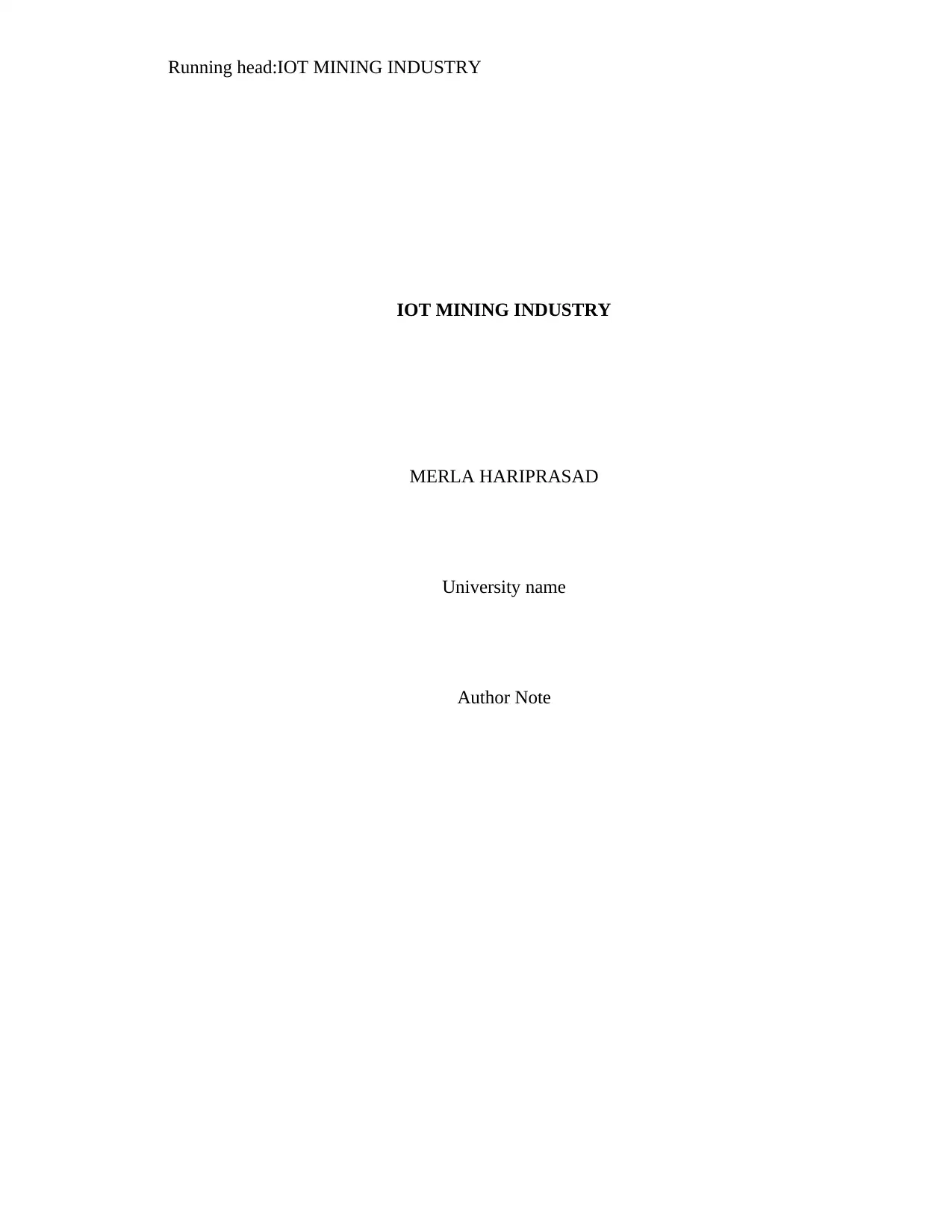
Running head:IOT MINING INDUSTRY
IOT MINING INDUSTRY
MERLA HARIPRASAD
University name
Author Note
IOT MINING INDUSTRY
MERLA HARIPRASAD
University name
Author Note
Paraphrase This Document
Need a fresh take? Get an instant paraphrase of this document with our AI Paraphraser
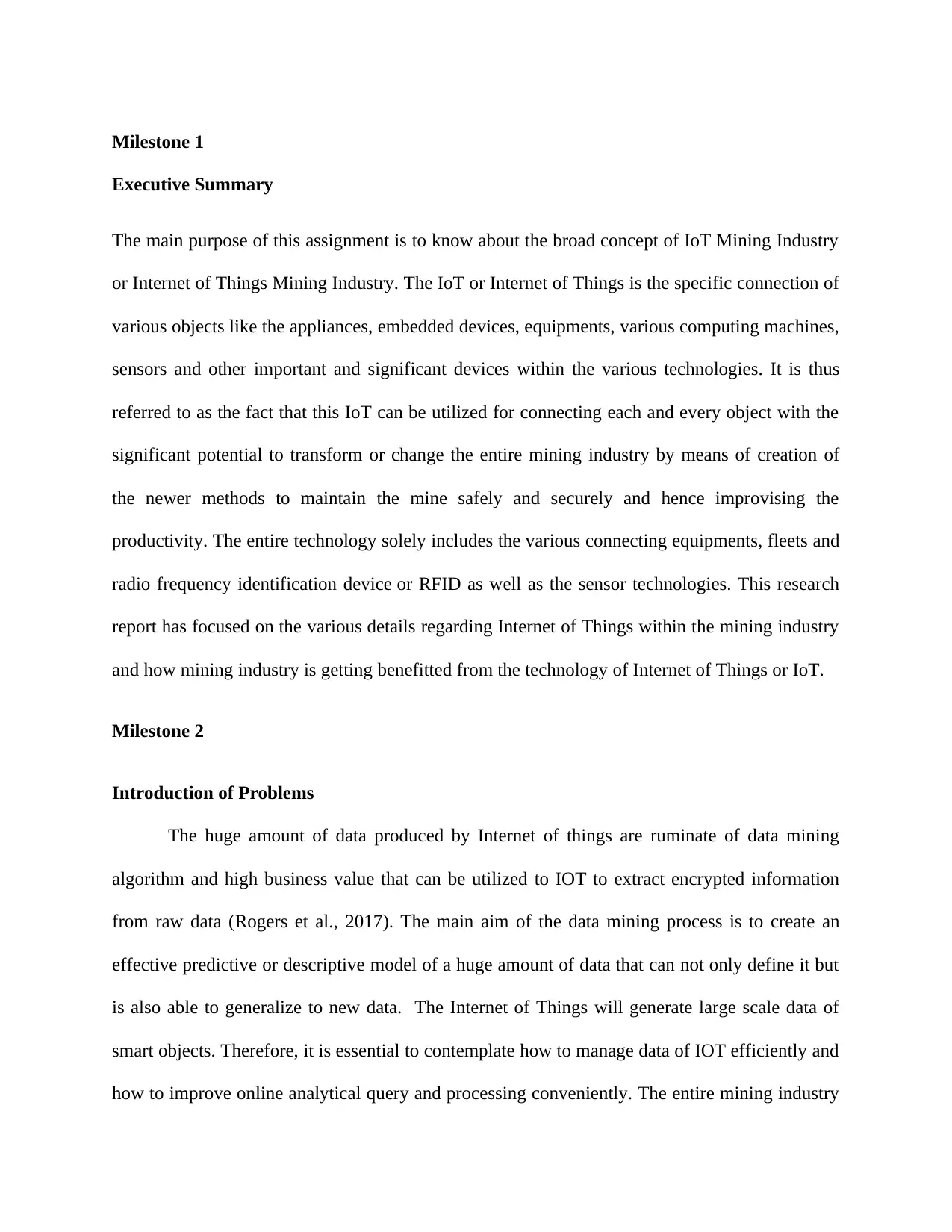
Milestone 1
Executive Summary
The main purpose of this assignment is to know about the broad concept of IoT Mining Industry
or Internet of Things Mining Industry. The IoT or Internet of Things is the specific connection of
various objects like the appliances, embedded devices, equipments, various computing machines,
sensors and other important and significant devices within the various technologies. It is thus
referred to as the fact that this IoT can be utilized for connecting each and every object with the
significant potential to transform or change the entire mining industry by means of creation of
the newer methods to maintain the mine safely and securely and hence improvising the
productivity. The entire technology solely includes the various connecting equipments, fleets and
radio frequency identification device or RFID as well as the sensor technologies. This research
report has focused on the various details regarding Internet of Things within the mining industry
and how mining industry is getting benefitted from the technology of Internet of Things or IoT.
Milestone 2
Introduction of Problems
The huge amount of data produced by Internet of things are ruminate of data mining
algorithm and high business value that can be utilized to IOT to extract encrypted information
from raw data (Rogers et al., 2017). The main aim of the data mining process is to create an
effective predictive or descriptive model of a huge amount of data that can not only define it but
is also able to generalize to new data. The Internet of Things will generate large scale data of
smart objects. Therefore, it is essential to contemplate how to manage data of IOT efficiently and
how to improve online analytical query and processing conveniently. The entire mining industry
Executive Summary
The main purpose of this assignment is to know about the broad concept of IoT Mining Industry
or Internet of Things Mining Industry. The IoT or Internet of Things is the specific connection of
various objects like the appliances, embedded devices, equipments, various computing machines,
sensors and other important and significant devices within the various technologies. It is thus
referred to as the fact that this IoT can be utilized for connecting each and every object with the
significant potential to transform or change the entire mining industry by means of creation of
the newer methods to maintain the mine safely and securely and hence improvising the
productivity. The entire technology solely includes the various connecting equipments, fleets and
radio frequency identification device or RFID as well as the sensor technologies. This research
report has focused on the various details regarding Internet of Things within the mining industry
and how mining industry is getting benefitted from the technology of Internet of Things or IoT.
Milestone 2
Introduction of Problems
The huge amount of data produced by Internet of things are ruminate of data mining
algorithm and high business value that can be utilized to IOT to extract encrypted information
from raw data (Rogers et al., 2017). The main aim of the data mining process is to create an
effective predictive or descriptive model of a huge amount of data that can not only define it but
is also able to generalize to new data. The Internet of Things will generate large scale data of
smart objects. Therefore, it is essential to contemplate how to manage data of IOT efficiently and
how to improve online analytical query and processing conveniently. The entire mining industry
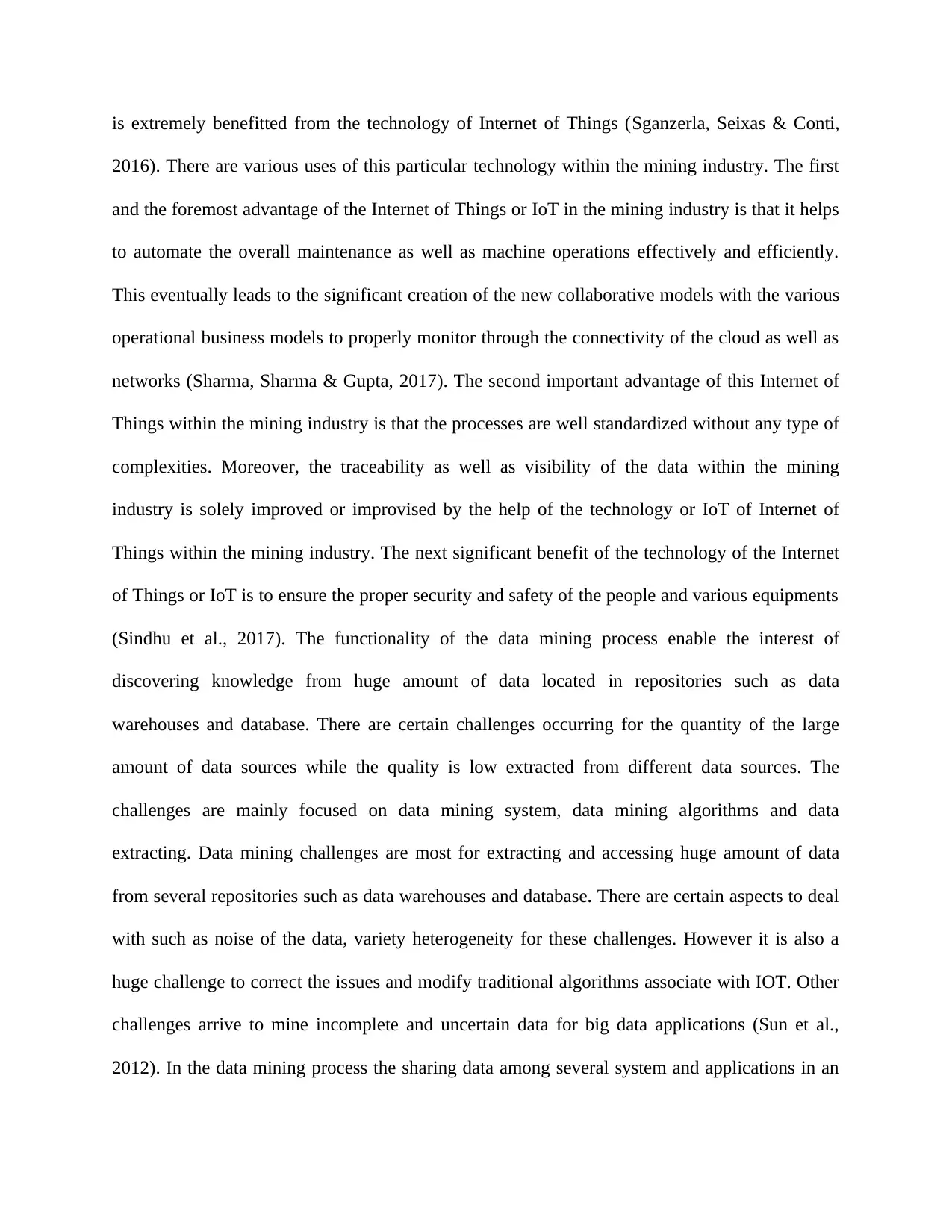
is extremely benefitted from the technology of Internet of Things (Sganzerla, Seixas & Conti,
2016). There are various uses of this particular technology within the mining industry. The first
and the foremost advantage of the Internet of Things or IoT in the mining industry is that it helps
to automate the overall maintenance as well as machine operations effectively and efficiently.
This eventually leads to the significant creation of the new collaborative models with the various
operational business models to properly monitor through the connectivity of the cloud as well as
networks (Sharma, Sharma & Gupta, 2017). The second important advantage of this Internet of
Things within the mining industry is that the processes are well standardized without any type of
complexities. Moreover, the traceability as well as visibility of the data within the mining
industry is solely improved or improvised by the help of the technology or IoT of Internet of
Things within the mining industry. The next significant benefit of the technology of the Internet
of Things or IoT is to ensure the proper security and safety of the people and various equipments
(Sindhu et al., 2017). The functionality of the data mining process enable the interest of
discovering knowledge from huge amount of data located in repositories such as data
warehouses and database. There are certain challenges occurring for the quantity of the large
amount of data sources while the quality is low extracted from different data sources. The
challenges are mainly focused on data mining system, data mining algorithms and data
extracting. Data mining challenges are most for extracting and accessing huge amount of data
from several repositories such as data warehouses and database. There are certain aspects to deal
with such as noise of the data, variety heterogeneity for these challenges. However it is also a
huge challenge to correct the issues and modify traditional algorithms associate with IOT. Other
challenges arrive to mine incomplete and uncertain data for big data applications (Sun et al.,
2012). In the data mining process the sharing data among several system and applications in an
2016). There are various uses of this particular technology within the mining industry. The first
and the foremost advantage of the Internet of Things or IoT in the mining industry is that it helps
to automate the overall maintenance as well as machine operations effectively and efficiently.
This eventually leads to the significant creation of the new collaborative models with the various
operational business models to properly monitor through the connectivity of the cloud as well as
networks (Sharma, Sharma & Gupta, 2017). The second important advantage of this Internet of
Things within the mining industry is that the processes are well standardized without any type of
complexities. Moreover, the traceability as well as visibility of the data within the mining
industry is solely improved or improvised by the help of the technology or IoT of Internet of
Things within the mining industry. The next significant benefit of the technology of the Internet
of Things or IoT is to ensure the proper security and safety of the people and various equipments
(Sindhu et al., 2017). The functionality of the data mining process enable the interest of
discovering knowledge from huge amount of data located in repositories such as data
warehouses and database. There are certain challenges occurring for the quantity of the large
amount of data sources while the quality is low extracted from different data sources. The
challenges are mainly focused on data mining system, data mining algorithms and data
extracting. Data mining challenges are most for extracting and accessing huge amount of data
from several repositories such as data warehouses and database. There are certain aspects to deal
with such as noise of the data, variety heterogeneity for these challenges. However it is also a
huge challenge to correct the issues and modify traditional algorithms associate with IOT. Other
challenges arrive to mine incomplete and uncertain data for big data applications (Sun et al.,
2012). In the data mining process the sharing data among several system and applications in an
⊘ This is a preview!⊘
Do you want full access?
Subscribe today to unlock all pages.

Trusted by 1+ million students worldwide
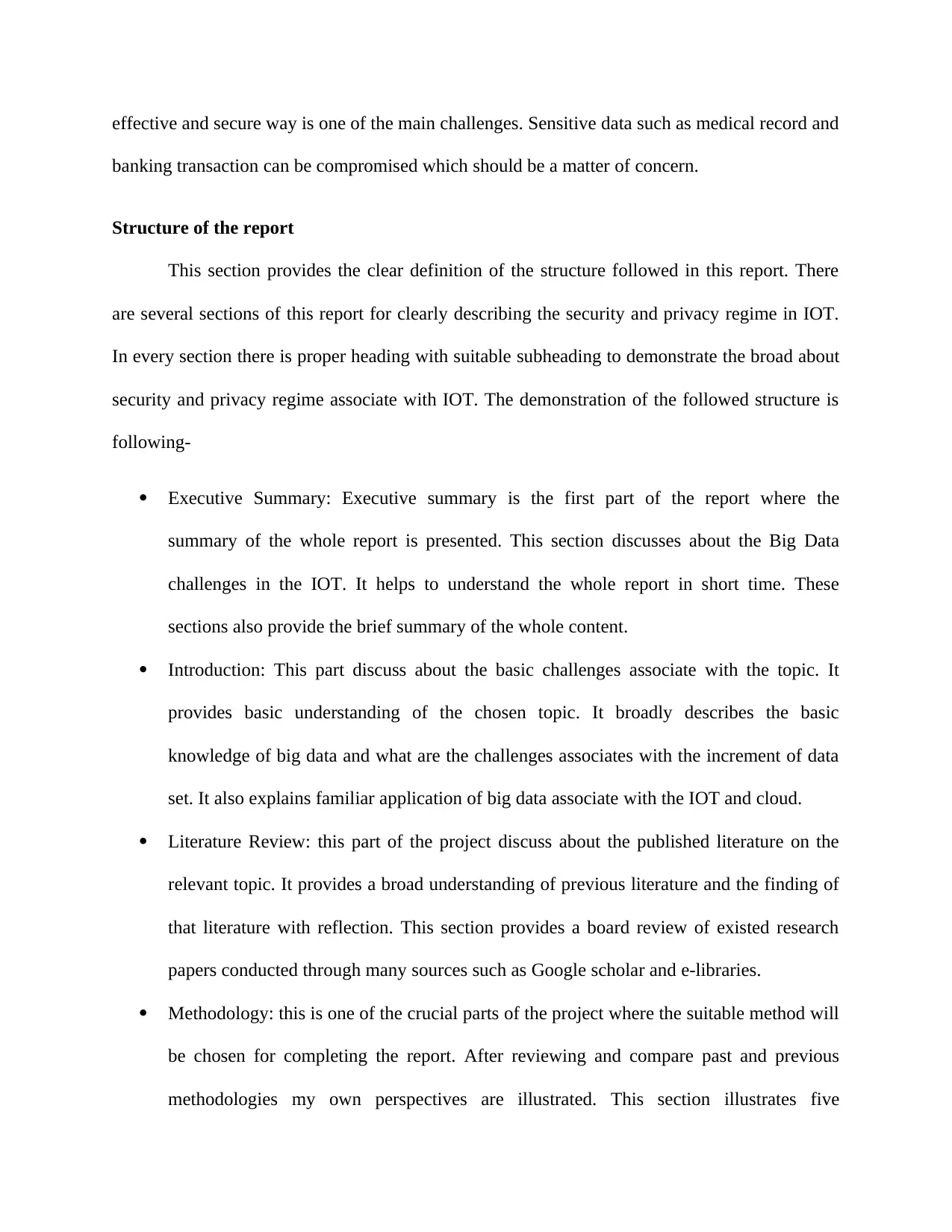
effective and secure way is one of the main challenges. Sensitive data such as medical record and
banking transaction can be compromised which should be a matter of concern.
Structure of the report
This section provides the clear definition of the structure followed in this report. There
are several sections of this report for clearly describing the security and privacy regime in IOT.
In every section there is proper heading with suitable subheading to demonstrate the broad about
security and privacy regime associate with IOT. The demonstration of the followed structure is
following-
Executive Summary: Executive summary is the first part of the report where the
summary of the whole report is presented. This section discusses about the Big Data
challenges in the IOT. It helps to understand the whole report in short time. These
sections also provide the brief summary of the whole content.
Introduction: This part discuss about the basic challenges associate with the topic. It
provides basic understanding of the chosen topic. It broadly describes the basic
knowledge of big data and what are the challenges associates with the increment of data
set. It also explains familiar application of big data associate with the IOT and cloud.
Literature Review: this part of the project discuss about the published literature on the
relevant topic. It provides a broad understanding of previous literature and the finding of
that literature with reflection. This section provides a board review of existed research
papers conducted through many sources such as Google scholar and e-libraries.
Methodology: this is one of the crucial parts of the project where the suitable method will
be chosen for completing the report. After reviewing and compare past and previous
methodologies my own perspectives are illustrated. This section illustrates five
banking transaction can be compromised which should be a matter of concern.
Structure of the report
This section provides the clear definition of the structure followed in this report. There
are several sections of this report for clearly describing the security and privacy regime in IOT.
In every section there is proper heading with suitable subheading to demonstrate the broad about
security and privacy regime associate with IOT. The demonstration of the followed structure is
following-
Executive Summary: Executive summary is the first part of the report where the
summary of the whole report is presented. This section discusses about the Big Data
challenges in the IOT. It helps to understand the whole report in short time. These
sections also provide the brief summary of the whole content.
Introduction: This part discuss about the basic challenges associate with the topic. It
provides basic understanding of the chosen topic. It broadly describes the basic
knowledge of big data and what are the challenges associates with the increment of data
set. It also explains familiar application of big data associate with the IOT and cloud.
Literature Review: this part of the project discuss about the published literature on the
relevant topic. It provides a broad understanding of previous literature and the finding of
that literature with reflection. This section provides a board review of existed research
papers conducted through many sources such as Google scholar and e-libraries.
Methodology: this is one of the crucial parts of the project where the suitable method will
be chosen for completing the report. After reviewing and compare past and previous
methodologies my own perspectives are illustrated. This section illustrates five
Paraphrase This Document
Need a fresh take? Get an instant paraphrase of this document with our AI Paraphraser
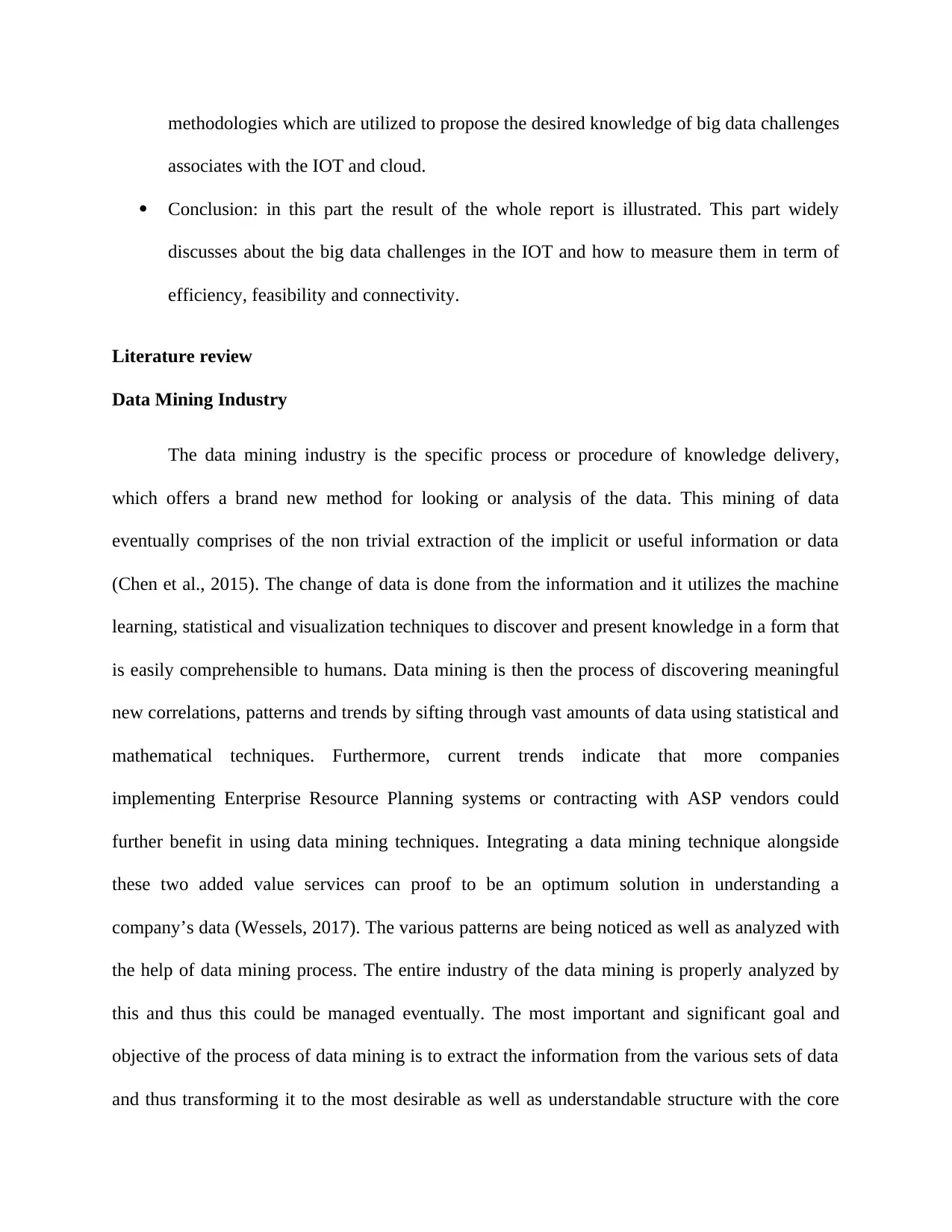
methodologies which are utilized to propose the desired knowledge of big data challenges
associates with the IOT and cloud.
Conclusion: in this part the result of the whole report is illustrated. This part widely
discusses about the big data challenges in the IOT and how to measure them in term of
efficiency, feasibility and connectivity.
Literature review
Data Mining Industry
The data mining industry is the specific process or procedure of knowledge delivery,
which offers a brand new method for looking or analysis of the data. This mining of data
eventually comprises of the non trivial extraction of the implicit or useful information or data
(Chen et al., 2015). The change of data is done from the information and it utilizes the machine
learning, statistical and visualization techniques to discover and present knowledge in a form that
is easily comprehensible to humans. Data mining is then the process of discovering meaningful
new correlations, patterns and trends by sifting through vast amounts of data using statistical and
mathematical techniques. Furthermore, current trends indicate that more companies
implementing Enterprise Resource Planning systems or contracting with ASP vendors could
further benefit in using data mining techniques. Integrating a data mining technique alongside
these two added value services can proof to be an optimum solution in understanding a
company’s data (Wessels, 2017). The various patterns are being noticed as well as analyzed with
the help of data mining process. The entire industry of the data mining is properly analyzed by
this and thus this could be managed eventually. The most important and significant goal and
objective of the process of data mining is to extract the information from the various sets of data
and thus transforming it to the most desirable as well as understandable structure with the core
associates with the IOT and cloud.
Conclusion: in this part the result of the whole report is illustrated. This part widely
discusses about the big data challenges in the IOT and how to measure them in term of
efficiency, feasibility and connectivity.
Literature review
Data Mining Industry
The data mining industry is the specific process or procedure of knowledge delivery,
which offers a brand new method for looking or analysis of the data. This mining of data
eventually comprises of the non trivial extraction of the implicit or useful information or data
(Chen et al., 2015). The change of data is done from the information and it utilizes the machine
learning, statistical and visualization techniques to discover and present knowledge in a form that
is easily comprehensible to humans. Data mining is then the process of discovering meaningful
new correlations, patterns and trends by sifting through vast amounts of data using statistical and
mathematical techniques. Furthermore, current trends indicate that more companies
implementing Enterprise Resource Planning systems or contracting with ASP vendors could
further benefit in using data mining techniques. Integrating a data mining technique alongside
these two added value services can proof to be an optimum solution in understanding a
company’s data (Wessels, 2017). The various patterns are being noticed as well as analyzed with
the help of data mining process. The entire industry of the data mining is properly analyzed by
this and thus this could be managed eventually. The most important and significant goal and
objective of the process of data mining is to extract the information from the various sets of data
and thus transforming it to the most desirable as well as understandable structure with the core
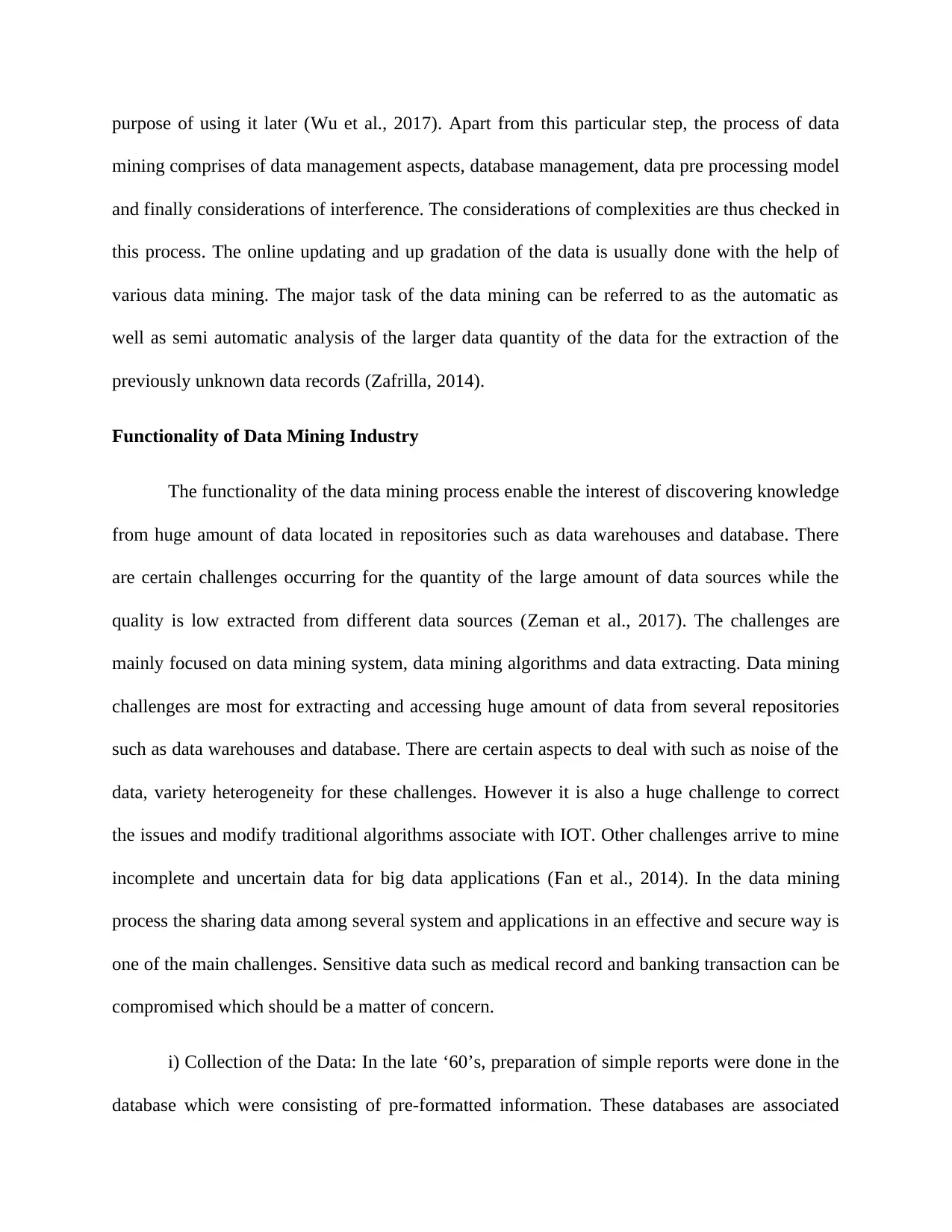
purpose of using it later (Wu et al., 2017). Apart from this particular step, the process of data
mining comprises of data management aspects, database management, data pre processing model
and finally considerations of interference. The considerations of complexities are thus checked in
this process. The online updating and up gradation of the data is usually done with the help of
various data mining. The major task of the data mining can be referred to as the automatic as
well as semi automatic analysis of the larger data quantity of the data for the extraction of the
previously unknown data records (Zafrilla, 2014).
Functionality of Data Mining Industry
The functionality of the data mining process enable the interest of discovering knowledge
from huge amount of data located in repositories such as data warehouses and database. There
are certain challenges occurring for the quantity of the large amount of data sources while the
quality is low extracted from different data sources (Zeman et al., 2017). The challenges are
mainly focused on data mining system, data mining algorithms and data extracting. Data mining
challenges are most for extracting and accessing huge amount of data from several repositories
such as data warehouses and database. There are certain aspects to deal with such as noise of the
data, variety heterogeneity for these challenges. However it is also a huge challenge to correct
the issues and modify traditional algorithms associate with IOT. Other challenges arrive to mine
incomplete and uncertain data for big data applications (Fan et al., 2014). In the data mining
process the sharing data among several system and applications in an effective and secure way is
one of the main challenges. Sensitive data such as medical record and banking transaction can be
compromised which should be a matter of concern.
i) Collection of the Data: In the late ‘60’s, preparation of simple reports were done in the
database which were consisting of pre-formatted information. These databases are associated
mining comprises of data management aspects, database management, data pre processing model
and finally considerations of interference. The considerations of complexities are thus checked in
this process. The online updating and up gradation of the data is usually done with the help of
various data mining. The major task of the data mining can be referred to as the automatic as
well as semi automatic analysis of the larger data quantity of the data for the extraction of the
previously unknown data records (Zafrilla, 2014).
Functionality of Data Mining Industry
The functionality of the data mining process enable the interest of discovering knowledge
from huge amount of data located in repositories such as data warehouses and database. There
are certain challenges occurring for the quantity of the large amount of data sources while the
quality is low extracted from different data sources (Zeman et al., 2017). The challenges are
mainly focused on data mining system, data mining algorithms and data extracting. Data mining
challenges are most for extracting and accessing huge amount of data from several repositories
such as data warehouses and database. There are certain aspects to deal with such as noise of the
data, variety heterogeneity for these challenges. However it is also a huge challenge to correct
the issues and modify traditional algorithms associate with IOT. Other challenges arrive to mine
incomplete and uncertain data for big data applications (Fan et al., 2014). In the data mining
process the sharing data among several system and applications in an effective and secure way is
one of the main challenges. Sensitive data such as medical record and banking transaction can be
compromised which should be a matter of concern.
i) Collection of the Data: In the late ‘60’s, preparation of simple reports were done in the
database which were consisting of pre-formatted information. These databases are associated
⊘ This is a preview!⊘
Do you want full access?
Subscribe today to unlock all pages.

Trusted by 1+ million students worldwide
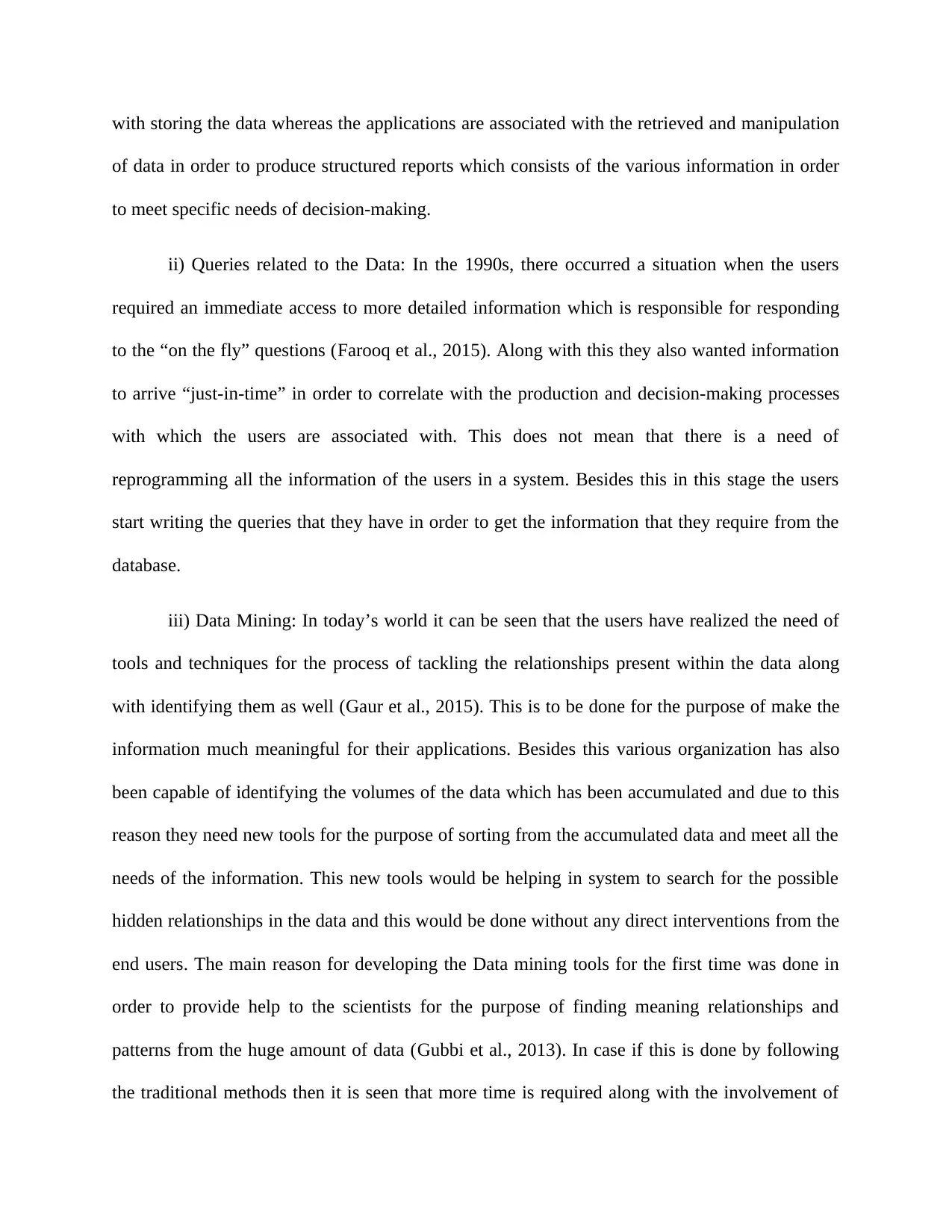
with storing the data whereas the applications are associated with the retrieved and manipulation
of data in order to produce structured reports which consists of the various information in order
to meet specific needs of decision-making.
ii) Queries related to the Data: In the 1990s, there occurred a situation when the users
required an immediate access to more detailed information which is responsible for responding
to the “on the fly” questions (Farooq et al., 2015). Along with this they also wanted information
to arrive “just-in-time” in order to correlate with the production and decision-making processes
with which the users are associated with. This does not mean that there is a need of
reprogramming all the information of the users in a system. Besides this in this stage the users
start writing the queries that they have in order to get the information that they require from the
database.
iii) Data Mining: In today’s world it can be seen that the users have realized the need of
tools and techniques for the process of tackling the relationships present within the data along
with identifying them as well (Gaur et al., 2015). This is to be done for the purpose of make the
information much meaningful for their applications. Besides this various organization has also
been capable of identifying the volumes of the data which has been accumulated and due to this
reason they need new tools for the purpose of sorting from the accumulated data and meet all the
needs of the information. This new tools would be helping in system to search for the possible
hidden relationships in the data and this would be done without any direct interventions from the
end users. The main reason for developing the Data mining tools for the first time was done in
order to provide help to the scientists for the purpose of finding meaning relationships and
patterns from the huge amount of data (Gubbi et al., 2013). In case if this is done by following
the traditional methods then it is seen that more time is required along with the involvement of
of data in order to produce structured reports which consists of the various information in order
to meet specific needs of decision-making.
ii) Queries related to the Data: In the 1990s, there occurred a situation when the users
required an immediate access to more detailed information which is responsible for responding
to the “on the fly” questions (Farooq et al., 2015). Along with this they also wanted information
to arrive “just-in-time” in order to correlate with the production and decision-making processes
with which the users are associated with. This does not mean that there is a need of
reprogramming all the information of the users in a system. Besides this in this stage the users
start writing the queries that they have in order to get the information that they require from the
database.
iii) Data Mining: In today’s world it can be seen that the users have realized the need of
tools and techniques for the process of tackling the relationships present within the data along
with identifying them as well (Gaur et al., 2015). This is to be done for the purpose of make the
information much meaningful for their applications. Besides this various organization has also
been capable of identifying the volumes of the data which has been accumulated and due to this
reason they need new tools for the purpose of sorting from the accumulated data and meet all the
needs of the information. This new tools would be helping in system to search for the possible
hidden relationships in the data and this would be done without any direct interventions from the
end users. The main reason for developing the Data mining tools for the first time was done in
order to provide help to the scientists for the purpose of finding meaning relationships and
patterns from the huge amount of data (Gubbi et al., 2013). In case if this is done by following
the traditional methods then it is seen that more time is required along with the involvement of
Paraphrase This Document
Need a fresh take? Get an instant paraphrase of this document with our AI Paraphraser
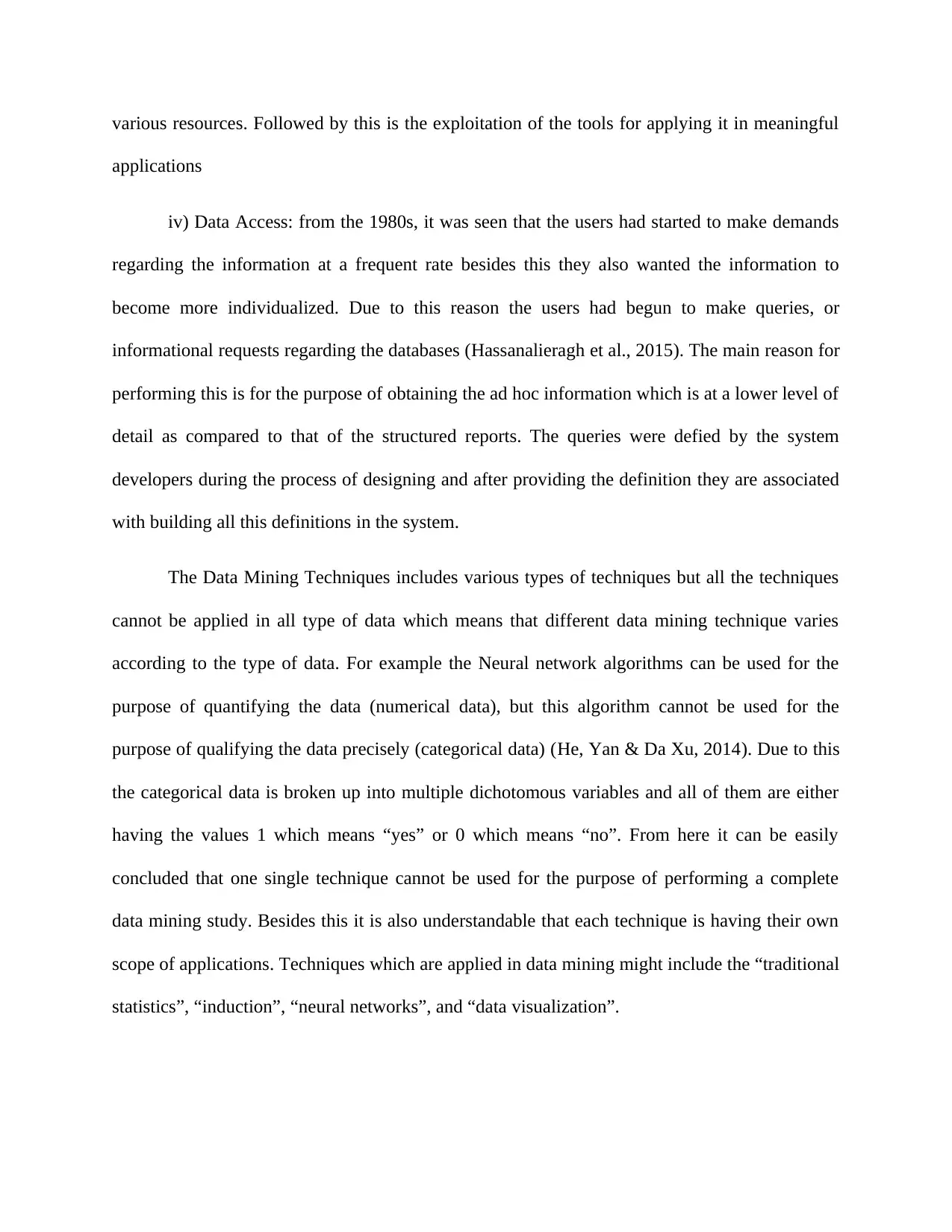
various resources. Followed by this is the exploitation of the tools for applying it in meaningful
applications
iv) Data Access: from the 1980s, it was seen that the users had started to make demands
regarding the information at a frequent rate besides this they also wanted the information to
become more individualized. Due to this reason the users had begun to make queries, or
informational requests regarding the databases (Hassanalieragh et al., 2015). The main reason for
performing this is for the purpose of obtaining the ad hoc information which is at a lower level of
detail as compared to that of the structured reports. The queries were defied by the system
developers during the process of designing and after providing the definition they are associated
with building all this definitions in the system.
The Data Mining Techniques includes various types of techniques but all the techniques
cannot be applied in all type of data which means that different data mining technique varies
according to the type of data. For example the Neural network algorithms can be used for the
purpose of quantifying the data (numerical data), but this algorithm cannot be used for the
purpose of qualifying the data precisely (categorical data) (He, Yan & Da Xu, 2014). Due to this
the categorical data is broken up into multiple dichotomous variables and all of them are either
having the values 1 which means “yes” or 0 which means “no”. From here it can be easily
concluded that one single technique cannot be used for the purpose of performing a complete
data mining study. Besides this it is also understandable that each technique is having their own
scope of applications. Techniques which are applied in data mining might include the “traditional
statistics”, “induction”, “neural networks”, and “data visualization”.
applications
iv) Data Access: from the 1980s, it was seen that the users had started to make demands
regarding the information at a frequent rate besides this they also wanted the information to
become more individualized. Due to this reason the users had begun to make queries, or
informational requests regarding the databases (Hassanalieragh et al., 2015). The main reason for
performing this is for the purpose of obtaining the ad hoc information which is at a lower level of
detail as compared to that of the structured reports. The queries were defied by the system
developers during the process of designing and after providing the definition they are associated
with building all this definitions in the system.
The Data Mining Techniques includes various types of techniques but all the techniques
cannot be applied in all type of data which means that different data mining technique varies
according to the type of data. For example the Neural network algorithms can be used for the
purpose of quantifying the data (numerical data), but this algorithm cannot be used for the
purpose of qualifying the data precisely (categorical data) (He, Yan & Da Xu, 2014). Due to this
the categorical data is broken up into multiple dichotomous variables and all of them are either
having the values 1 which means “yes” or 0 which means “no”. From here it can be easily
concluded that one single technique cannot be used for the purpose of performing a complete
data mining study. Besides this it is also understandable that each technique is having their own
scope of applications. Techniques which are applied in data mining might include the “traditional
statistics”, “induction”, “neural networks”, and “data visualization”.
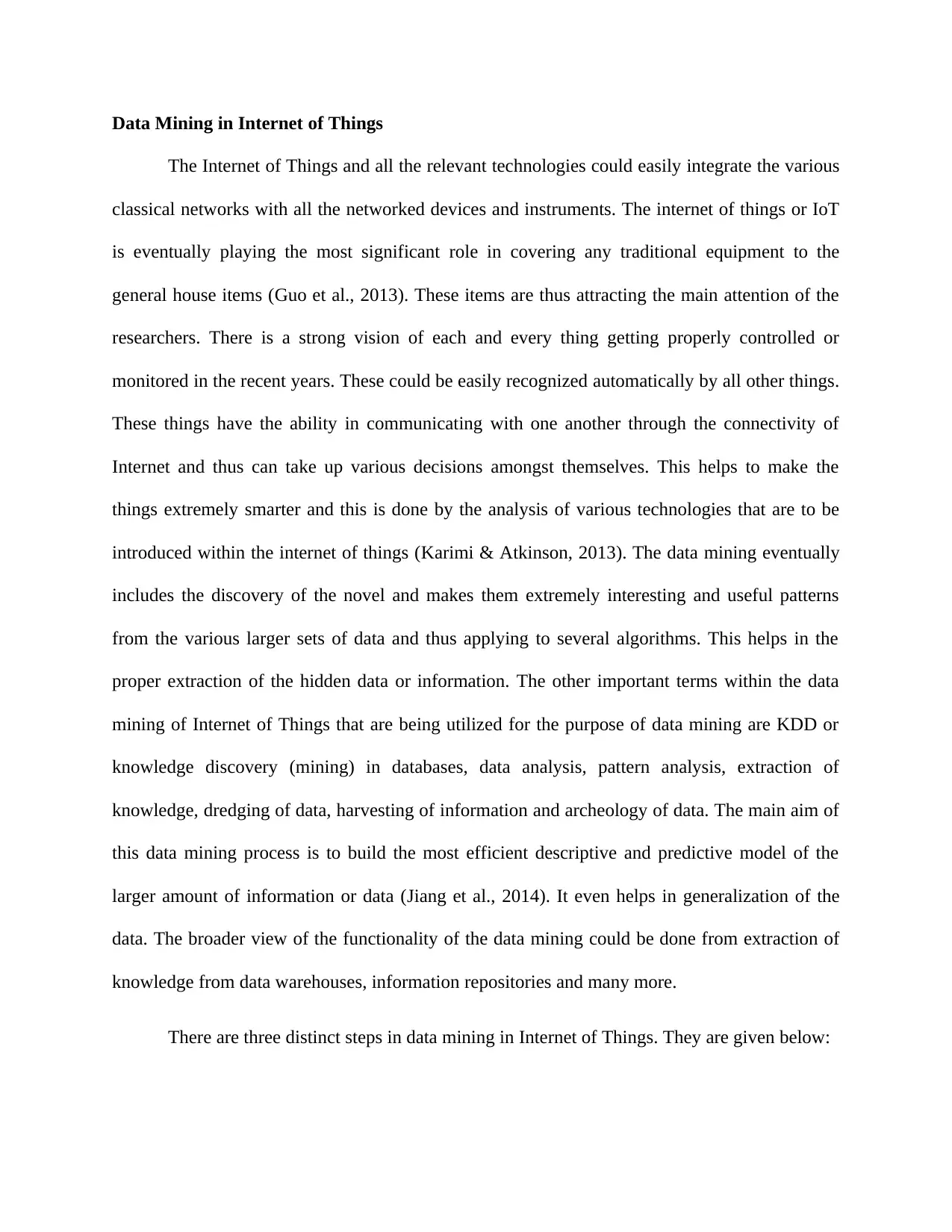
Data Mining in Internet of Things
The Internet of Things and all the relevant technologies could easily integrate the various
classical networks with all the networked devices and instruments. The internet of things or IoT
is eventually playing the most significant role in covering any traditional equipment to the
general house items (Guo et al., 2013). These items are thus attracting the main attention of the
researchers. There is a strong vision of each and every thing getting properly controlled or
monitored in the recent years. These could be easily recognized automatically by all other things.
These things have the ability in communicating with one another through the connectivity of
Internet and thus can take up various decisions amongst themselves. This helps to make the
things extremely smarter and this is done by the analysis of various technologies that are to be
introduced within the internet of things (Karimi & Atkinson, 2013). The data mining eventually
includes the discovery of the novel and makes them extremely interesting and useful patterns
from the various larger sets of data and thus applying to several algorithms. This helps in the
proper extraction of the hidden data or information. The other important terms within the data
mining of Internet of Things that are being utilized for the purpose of data mining are KDD or
knowledge discovery (mining) in databases, data analysis, pattern analysis, extraction of
knowledge, dredging of data, harvesting of information and archeology of data. The main aim of
this data mining process is to build the most efficient descriptive and predictive model of the
larger amount of information or data (Jiang et al., 2014). It even helps in generalization of the
data. The broader view of the functionality of the data mining could be done from extraction of
knowledge from data warehouses, information repositories and many more.
There are three distinct steps in data mining in Internet of Things. They are given below:
The Internet of Things and all the relevant technologies could easily integrate the various
classical networks with all the networked devices and instruments. The internet of things or IoT
is eventually playing the most significant role in covering any traditional equipment to the
general house items (Guo et al., 2013). These items are thus attracting the main attention of the
researchers. There is a strong vision of each and every thing getting properly controlled or
monitored in the recent years. These could be easily recognized automatically by all other things.
These things have the ability in communicating with one another through the connectivity of
Internet and thus can take up various decisions amongst themselves. This helps to make the
things extremely smarter and this is done by the analysis of various technologies that are to be
introduced within the internet of things (Karimi & Atkinson, 2013). The data mining eventually
includes the discovery of the novel and makes them extremely interesting and useful patterns
from the various larger sets of data and thus applying to several algorithms. This helps in the
proper extraction of the hidden data or information. The other important terms within the data
mining of Internet of Things that are being utilized for the purpose of data mining are KDD or
knowledge discovery (mining) in databases, data analysis, pattern analysis, extraction of
knowledge, dredging of data, harvesting of information and archeology of data. The main aim of
this data mining process is to build the most efficient descriptive and predictive model of the
larger amount of information or data (Jiang et al., 2014). It even helps in generalization of the
data. The broader view of the functionality of the data mining could be done from extraction of
knowledge from data warehouses, information repositories and many more.
There are three distinct steps in data mining in Internet of Things. They are given below:
⊘ This is a preview!⊘
Do you want full access?
Subscribe today to unlock all pages.

Trusted by 1+ million students worldwide
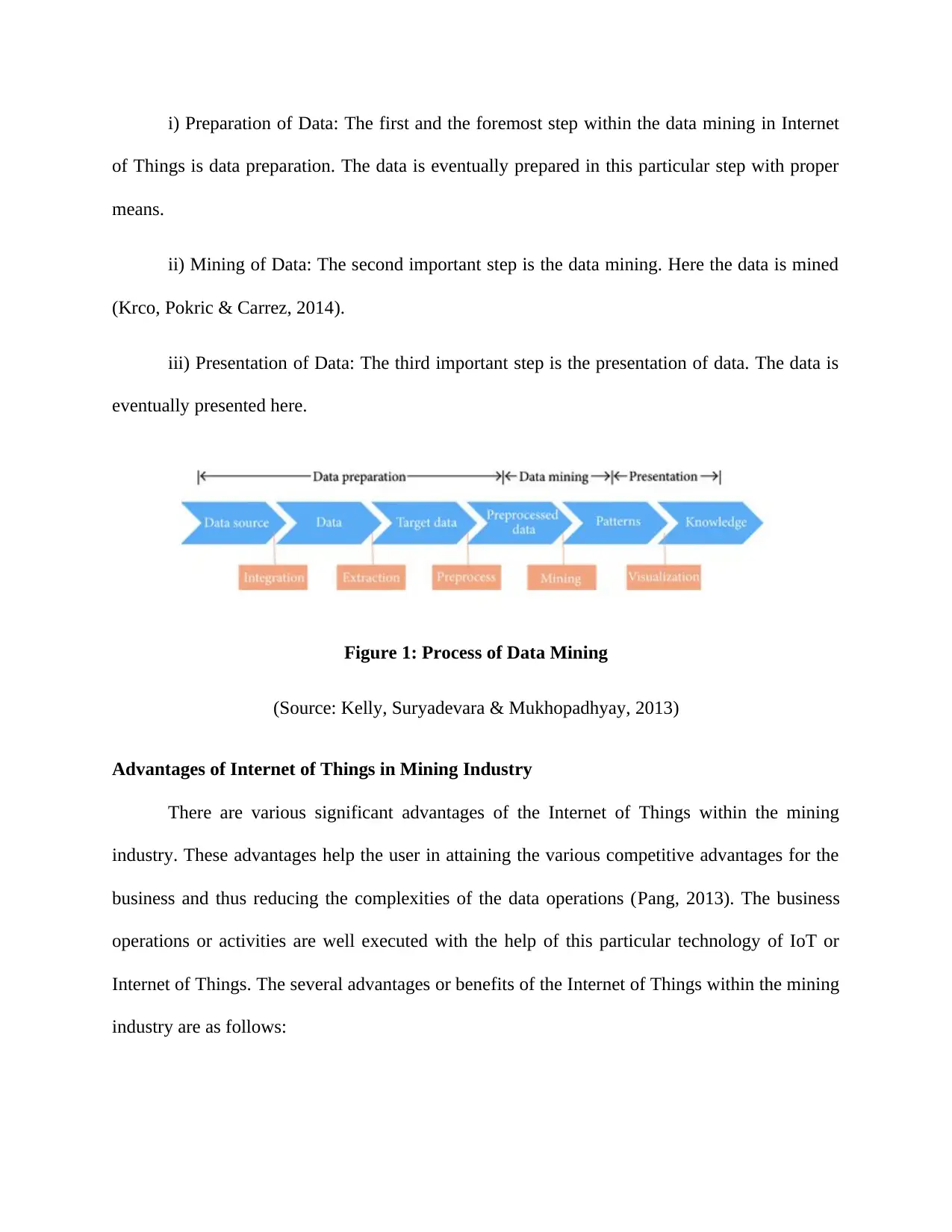
i) Preparation of Data: The first and the foremost step within the data mining in Internet
of Things is data preparation. The data is eventually prepared in this particular step with proper
means.
ii) Mining of Data: The second important step is the data mining. Here the data is mined
(Krco, Pokric & Carrez, 2014).
iii) Presentation of Data: The third important step is the presentation of data. The data is
eventually presented here.
Figure 1: Process of Data Mining
(Source: Kelly, Suryadevara & Mukhopadhyay, 2013)
Advantages of Internet of Things in Mining Industry
There are various significant advantages of the Internet of Things within the mining
industry. These advantages help the user in attaining the various competitive advantages for the
business and thus reducing the complexities of the data operations (Pang, 2013). The business
operations or activities are well executed with the help of this particular technology of IoT or
Internet of Things. The several advantages or benefits of the Internet of Things within the mining
industry are as follows:
of Things is data preparation. The data is eventually prepared in this particular step with proper
means.
ii) Mining of Data: The second important step is the data mining. Here the data is mined
(Krco, Pokric & Carrez, 2014).
iii) Presentation of Data: The third important step is the presentation of data. The data is
eventually presented here.
Figure 1: Process of Data Mining
(Source: Kelly, Suryadevara & Mukhopadhyay, 2013)
Advantages of Internet of Things in Mining Industry
There are various significant advantages of the Internet of Things within the mining
industry. These advantages help the user in attaining the various competitive advantages for the
business and thus reducing the complexities of the data operations (Pang, 2013). The business
operations or activities are well executed with the help of this particular technology of IoT or
Internet of Things. The several advantages or benefits of the Internet of Things within the mining
industry are as follows:
Paraphrase This Document
Need a fresh take? Get an instant paraphrase of this document with our AI Paraphraser
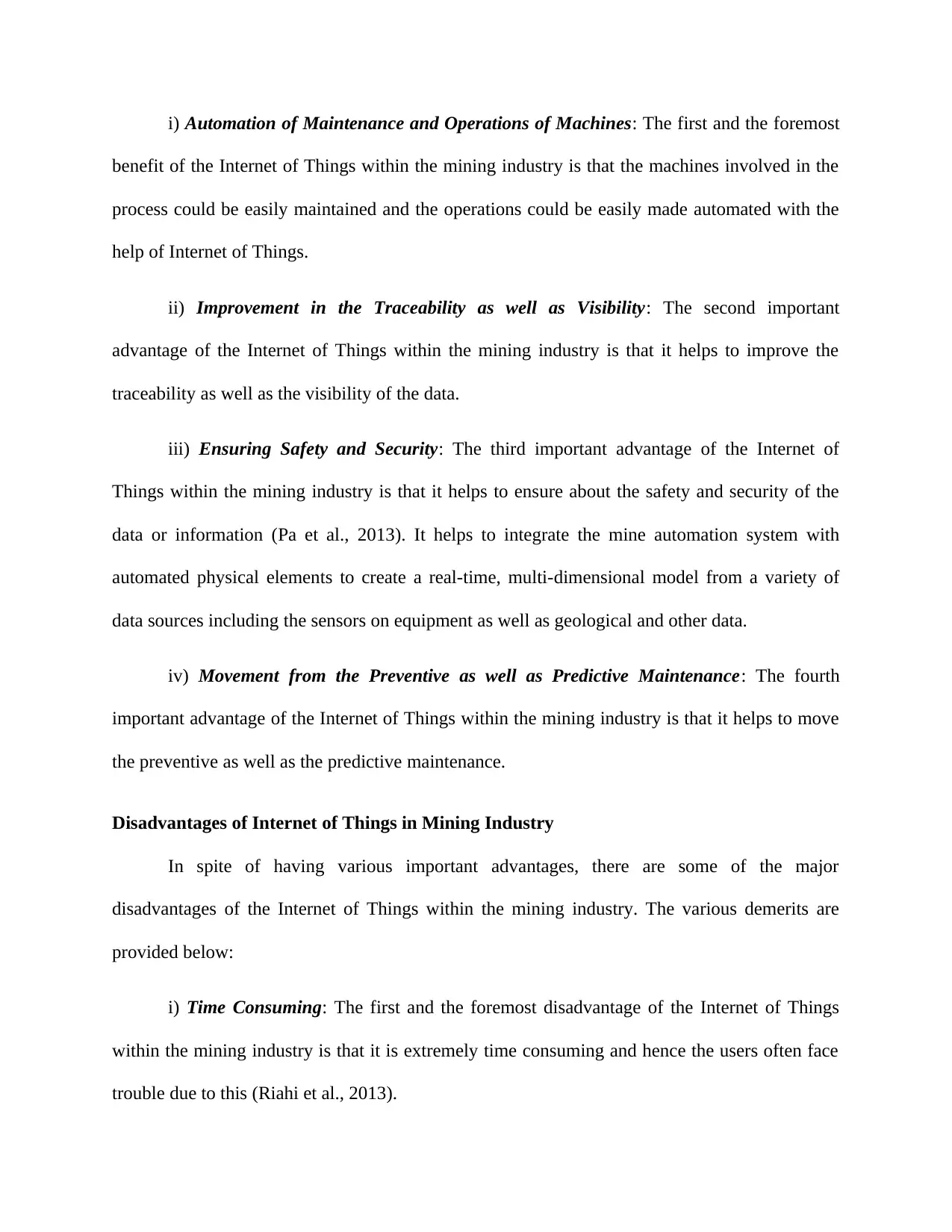
i) Automation of Maintenance and Operations of Machines: The first and the foremost
benefit of the Internet of Things within the mining industry is that the machines involved in the
process could be easily maintained and the operations could be easily made automated with the
help of Internet of Things.
ii) Improvement in the Traceability as well as Visibility: The second important
advantage of the Internet of Things within the mining industry is that it helps to improve the
traceability as well as the visibility of the data.
iii) Ensuring Safety and Security: The third important advantage of the Internet of
Things within the mining industry is that it helps to ensure about the safety and security of the
data or information (Pa et al., 2013). It helps to integrate the mine automation system with
automated physical elements to create a real-time, multi-dimensional model from a variety of
data sources including the sensors on equipment as well as geological and other data.
iv) Movement from the Preventive as well as Predictive Maintenance: The fourth
important advantage of the Internet of Things within the mining industry is that it helps to move
the preventive as well as the predictive maintenance.
Disadvantages of Internet of Things in Mining Industry
In spite of having various important advantages, there are some of the major
disadvantages of the Internet of Things within the mining industry. The various demerits are
provided below:
i) Time Consuming: The first and the foremost disadvantage of the Internet of Things
within the mining industry is that it is extremely time consuming and hence the users often face
trouble due to this (Riahi et al., 2013).
benefit of the Internet of Things within the mining industry is that the machines involved in the
process could be easily maintained and the operations could be easily made automated with the
help of Internet of Things.
ii) Improvement in the Traceability as well as Visibility: The second important
advantage of the Internet of Things within the mining industry is that it helps to improve the
traceability as well as the visibility of the data.
iii) Ensuring Safety and Security: The third important advantage of the Internet of
Things within the mining industry is that it helps to ensure about the safety and security of the
data or information (Pa et al., 2013). It helps to integrate the mine automation system with
automated physical elements to create a real-time, multi-dimensional model from a variety of
data sources including the sensors on equipment as well as geological and other data.
iv) Movement from the Preventive as well as Predictive Maintenance: The fourth
important advantage of the Internet of Things within the mining industry is that it helps to move
the preventive as well as the predictive maintenance.
Disadvantages of Internet of Things in Mining Industry
In spite of having various important advantages, there are some of the major
disadvantages of the Internet of Things within the mining industry. The various demerits are
provided below:
i) Time Consuming: The first and the foremost disadvantage of the Internet of Things
within the mining industry is that it is extremely time consuming and hence the users often face
trouble due to this (Riahi et al., 2013).
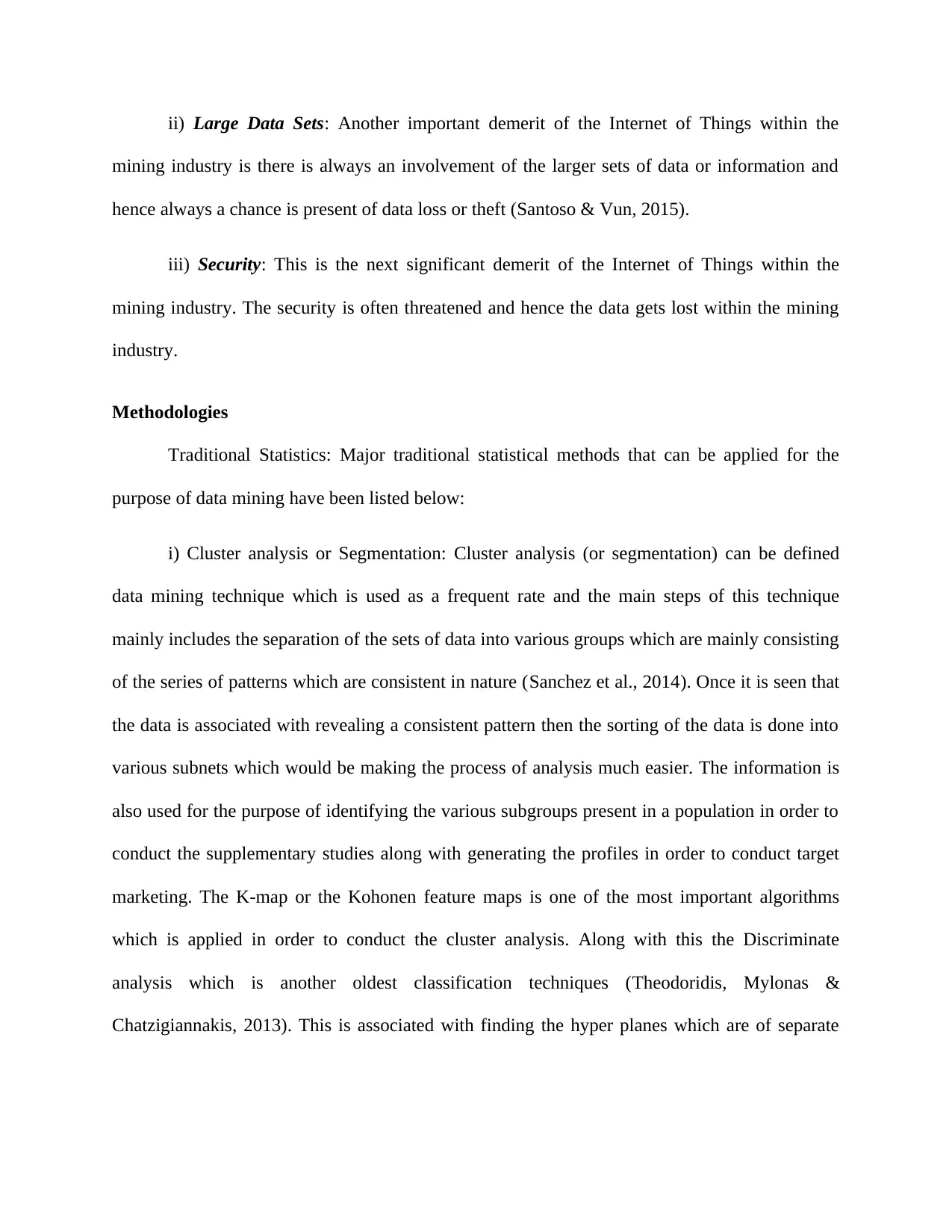
ii) Large Data Sets: Another important demerit of the Internet of Things within the
mining industry is there is always an involvement of the larger sets of data or information and
hence always a chance is present of data loss or theft (Santoso & Vun, 2015).
iii) Security: This is the next significant demerit of the Internet of Things within the
mining industry. The security is often threatened and hence the data gets lost within the mining
industry.
Methodologies
Traditional Statistics: Major traditional statistical methods that can be applied for the
purpose of data mining have been listed below:
i) Cluster analysis or Segmentation: Cluster analysis (or segmentation) can be defined
data mining technique which is used as a frequent rate and the main steps of this technique
mainly includes the separation of the sets of data into various groups which are mainly consisting
of the series of patterns which are consistent in nature (Sanchez et al., 2014). Once it is seen that
the data is associated with revealing a consistent pattern then the sorting of the data is done into
various subnets which would be making the process of analysis much easier. The information is
also used for the purpose of identifying the various subgroups present in a population in order to
conduct the supplementary studies along with generating the profiles in order to conduct target
marketing. The K-map or the Kohonen feature maps is one of the most important algorithms
which is applied in order to conduct the cluster analysis. Along with this the Discriminate
analysis which is another oldest classification techniques (Theodoridis, Mylonas &
Chatzigiannakis, 2013). This is associated with finding the hyper planes which are of separate
mining industry is there is always an involvement of the larger sets of data or information and
hence always a chance is present of data loss or theft (Santoso & Vun, 2015).
iii) Security: This is the next significant demerit of the Internet of Things within the
mining industry. The security is often threatened and hence the data gets lost within the mining
industry.
Methodologies
Traditional Statistics: Major traditional statistical methods that can be applied for the
purpose of data mining have been listed below:
i) Cluster analysis or Segmentation: Cluster analysis (or segmentation) can be defined
data mining technique which is used as a frequent rate and the main steps of this technique
mainly includes the separation of the sets of data into various groups which are mainly consisting
of the series of patterns which are consistent in nature (Sanchez et al., 2014). Once it is seen that
the data is associated with revealing a consistent pattern then the sorting of the data is done into
various subnets which would be making the process of analysis much easier. The information is
also used for the purpose of identifying the various subgroups present in a population in order to
conduct the supplementary studies along with generating the profiles in order to conduct target
marketing. The K-map or the Kohonen feature maps is one of the most important algorithms
which is applied in order to conduct the cluster analysis. Along with this the Discriminate
analysis which is another oldest classification techniques (Theodoridis, Mylonas &
Chatzigiannakis, 2013). This is associated with finding the hyper planes which are of separate
⊘ This is a preview!⊘
Do you want full access?
Subscribe today to unlock all pages.

Trusted by 1+ million students worldwide
1 out of 20
Related Documents
Your All-in-One AI-Powered Toolkit for Academic Success.
+13062052269
info@desklib.com
Available 24*7 on WhatsApp / Email
![[object Object]](/_next/static/media/star-bottom.7253800d.svg)
Unlock your academic potential
Copyright © 2020–2025 A2Z Services. All Rights Reserved. Developed and managed by ZUCOL.



